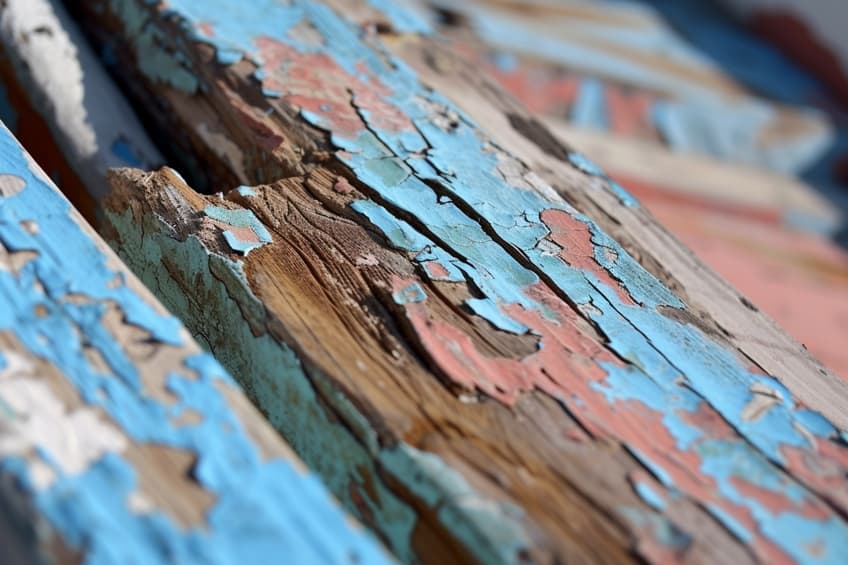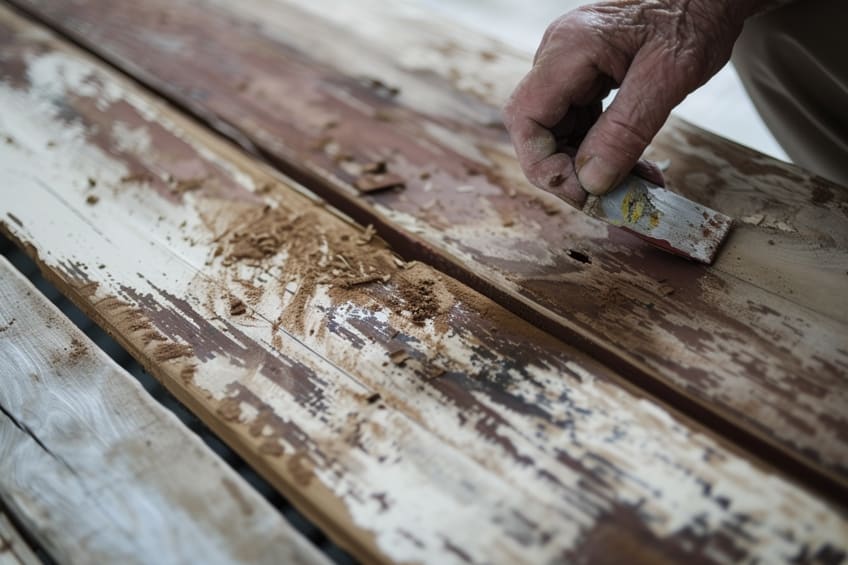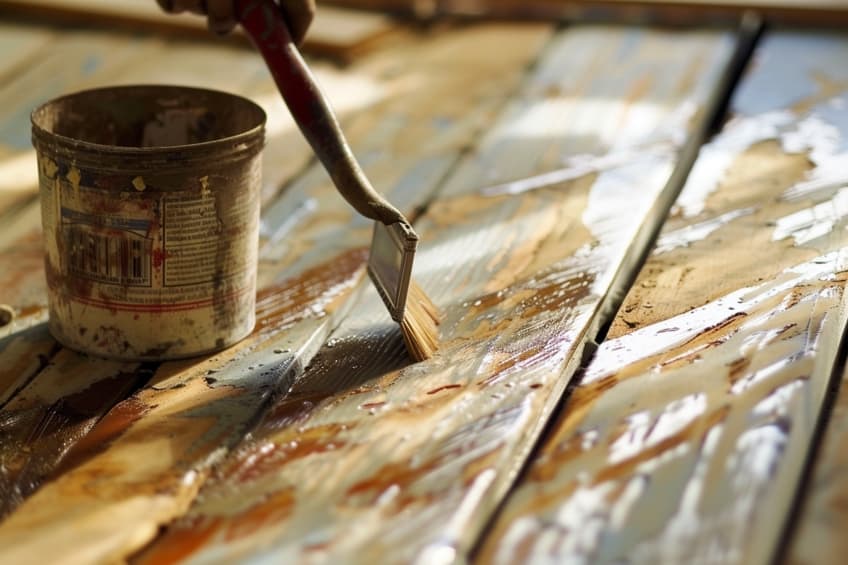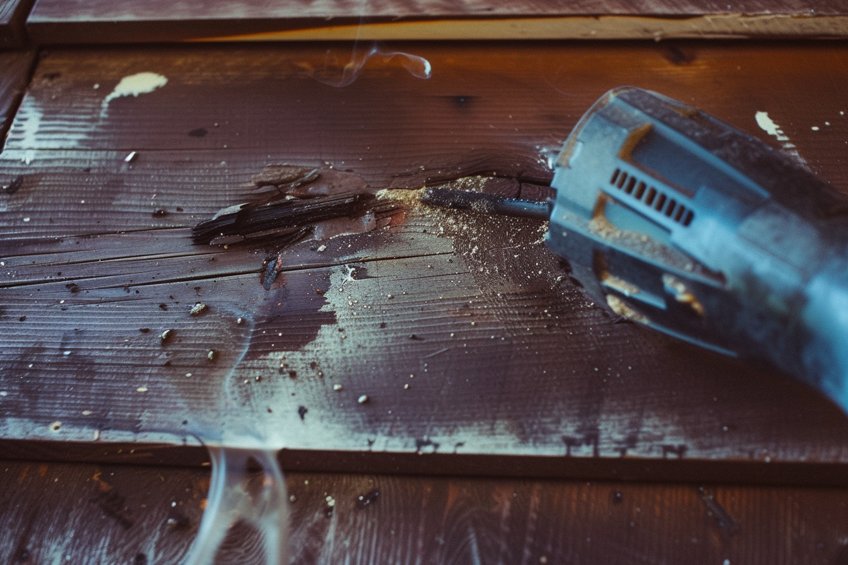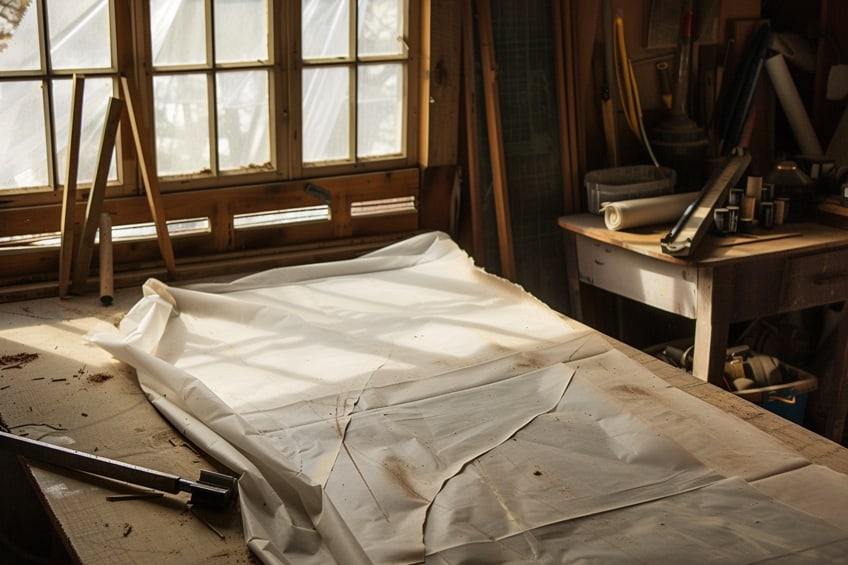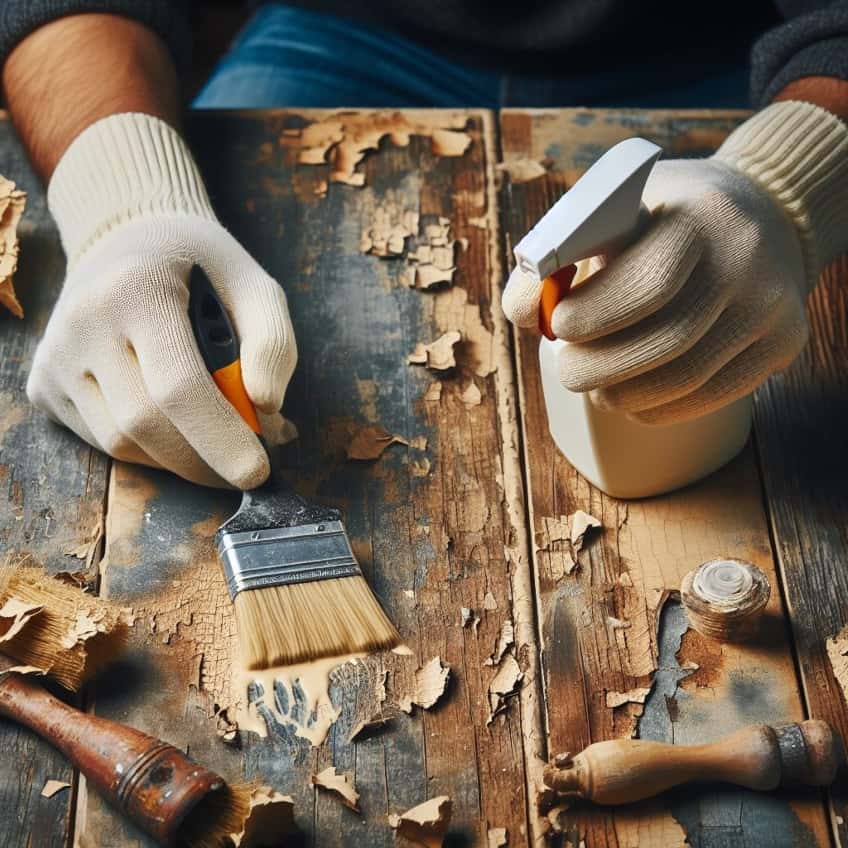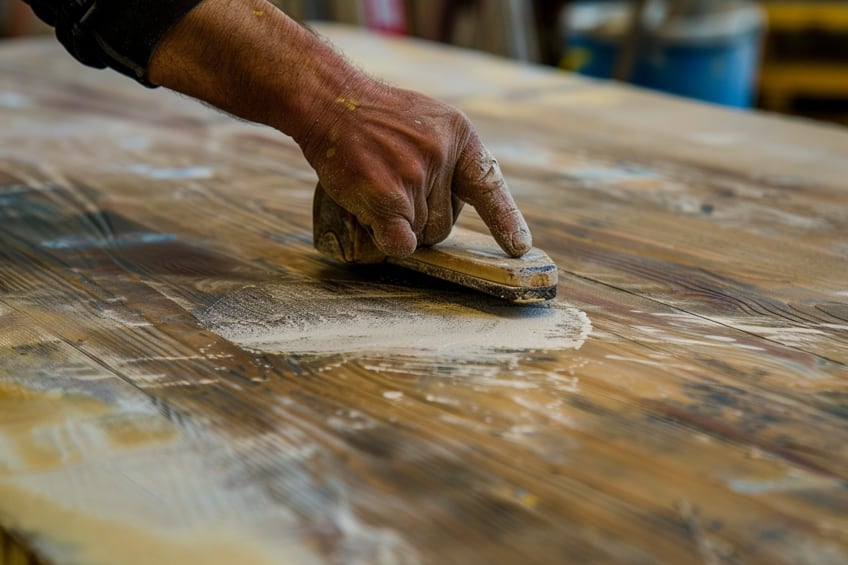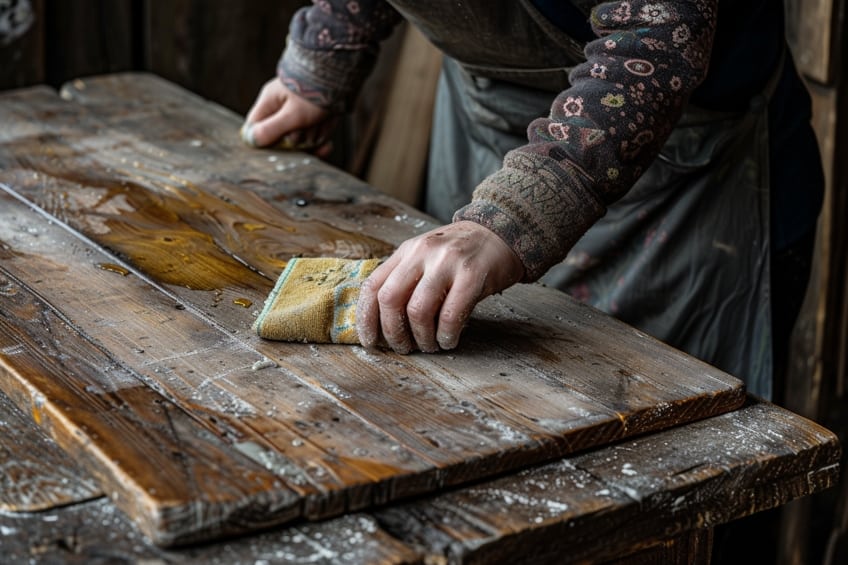How to Strip Paint from Wood – Back to Basics
This post may contain affiliate links. We may earn a small commission from purchases made through them, at no additional cost to you. You help to support resin-expert.com
Stripping paint from wood can rejuvenate tired surfaces and reveal the natural beauty of the grain beneath. Whether you’re restoring an antique piece of furniture or refreshing your home’s trim, knowing how to strip paint effectively is a valuable skill for any DIY enthusiast. However, the process requires careful attention to detail and the right tools to ensure success without damaging the wood underneath. In this guide, we’ll explore step-by-step techniques, essential tools, and safety precautions to help you master the art of paint stripping and bring new life to your wooden surfaces!
Table of Contents
Key Takeaways
- Paint stripping prepares wood for new paint or restores its original state.
- The method chosen depends on paint type and wood condition.
- Safety and preparation are crucial before starting paint removal.
Why Do I Have to Strip Paint from Wood?
Stripping paint from wood is critical for several reasons, mostly revolving around renovation, restoration, and maintenance practices. Firstly, preparation for a new paint job often requires the removal of the old paint. This is because applying new paint over the old can lead to poor adhesion, and the eventual peeling of the new layer. Ensuring a smooth, clean surface allows the new paint to adhere better and last longer. In some cases, paint stripping is done to restore wood to its original state. When the goal is to apply a clear coat or different finish, it’s imperative to strip away the existing paint to reveal the natural wood beneath.
This is particularly important for historic or fine woodworking where the wood’s appearance is a significant aspect of its value.
Another reason for stripping paint is to remedy previous painting errors or damage. If the paint is peeling, bubbling, or has become uneven, it’s important to remove the compromised layers before repainting or refinishing. Lastly, when converting the finish of wood from paint to stain, it’s necessary to strip off paint. Stain penetrates wood and cannot do so effectively with a layer of paint obstructing it. For a successful transition, the wood must be bare to accept the stain properly.
Identifying the Type of Paint and Wood
Before embarking on the task of stripping paint from wood, it is crucial to identify the type of paint and the wood it covers. This knowledge will dictate the appropriate removal method to avoid damaging the wood.
Paint Type
There are two primary types of paint: water-based and oil-based. Water-based paint, also known as latex paint, is flexible and easy to clean up with soap and water. Oil-based paint is durable, but requires mineral spirits for cleanup. To determine the type of paint, perform a solvent test by gently rubbing a cotton swab dampened with rubbing alcohol on a small area of the paint. If the swab picks up paint, it’s likely water-based; if not, it’s probably oil-based.
For homes built before the 1970s, it’s essential to test for lead-based paint, a hazardous material that requires special handling.
Wood Type
Different wood species can tolerate different stripping methods. Softwoods, such as pine, are more prone to damage, whereas hardwoods, like oak, are more resilient. To identify the wood, inspect its grain patterns and color; hardwoods typically exhibit a more intricate grain and richer coloration. Perform a gentle scratch test in an inconspicuous area; softwoods scratch easily compared to hardwoods. Identifying both the type of paint and the wood serves as the bedrock for selecting a safe and effective paint removal method.
Methods of Paint Removal
When removing paint from wood, it’s essential to choose a method that matches the project’s demands. Some techniques may be quicker, others gentler on the wood, and each has its own set of precautions and steps to follow.
Chemical Stripping
Chemical strippers are a popular choice for paint removal as they can soften multiple layers of paint, allowing for easier scraping without damaging the wood grain. Two common types include:
- Solvent-based strippers (e.g., peel away): These typically work faster but require good ventilation due to strong odors and potentially harmful fumes.
- Biochemical strippers (e.g., citristrip): These are less toxic and have a citrus-based formula, making them more environmentally friendly but slower in action.
For both types, one applies the paint stripper with a brush, leaves it to act for the recommended time, and then scrapes the paint off.
Sanding
Sanding is a mechanical means of paint removal that involves using abrasive materials to wear away paint layers. The process can be manual or aided by power tools:
- Manual sanding: Utilizing sandpaper (coarse grit is recommended to start), the user manually rubs the paint to wear it away. This method is labor-intensive but offers control over the pressure applied.
- Power sanding: A power sander can greatly speed up the work. It’s important to move the sander constantly to avoid gouging the wood.
One should always sand with the grain of the wood to prevent damaging its surface.
Heat-Based Techniques
Using heat to strip paint can be an effective way to break the bond between the paint and the wood:
- Heat guns: They deliver a stream of hot air that softens the paint, making it easy to scrape away.
- Infrared devices: These heat the paint without producing a strong airflow, reducing the risk of dispersing lead-based paint particles.
While using heat-based techniques, one must be cautious to avoid scorching the wood or causing a fire hazard.
Preparation and Safety
Before starting the paint stripping process, the reader must ensure that the workspace is adequately prepared and personal safety measures are in place. These preliminary steps are vital to prevent any accidents or health hazards.
Work Area Preparation
The work area should be well-ventilated to mitigate the risks associated with volatile organic compounds (VOCs) that are often found in paint and chemical paint strippers. If working indoors, windows should be opened, and fans should be used to circulate air. Cover the surrounding area with drop cloths to protect surfaces from spills and drips. Any nearby water sources should be safeguarded to prevent contamination from paint and chemicals.
Personal Protective Equipment
Personal safety gear required includes several essential items to protect yourself during paint stripping tasks. Firstly, respiratory protection is crucial; utilize a respirator mask rated for VOCs to prevent inhalation of harmful fumes. Secondly, ensure skin protection with nitrile or rubber gloves to avoid direct contact with paint or mineral spirits. Additionally, wear safety goggles to shield the eyes from splashes. Always adhere to the manufacturer’s safety instructions when handling chemical paint strippers or mineral spirits. It’s wise to have water readily accessible for quick rinsing in case of accidental exposure.
Prioritizing personal safety is paramount when engaging in paint-stripping activities.
Paint Removal Techniques and Tools
Removing paint from wood requires the right approach and tools to ensure the underlying surface is not damaged. Whether using manual methods, power tools, or eco-friendly options, the goal is to effectively strip away the paint while preserving the wood.
Manual Stripping Tools
Manual tools are often the go-to for smaller projects or delicate surfaces where precision is key.
- Putty knives and paint scrapers: A plastic putty knife is less likely to damage the wood and is ideal for scraping off loosened paint. For tougher jobs, a metal paint scraper or utility knife might be necessary.
- Wire brushes and steel wool: For removing residue and cleaning the wood after the primary paint removal, wire brushes and steel wool can be helpful.
Power Tools
When needing to strip paint more efficiently from larger areas, power tools can significantly reduce labor.
- Heat guns: Applying heat to the paint makes it bubble up, allowing for easier scraping. However, care must be taken due to the high temperatures involved.
- Sanders: From orbital to belt sanders, these power tools effectively remove paint while also smoothing the wood surface.
Alternative and Eco-Friendly Options
For those looking for safer and environmentally friendlier methods, the following options are preferred.
- Chemical strippers: Products like citrus-based paint removers and chemical strippers containing methylene chloride are effective but require safety precautions due to potentially hazardous fumes.
- Citrus strippers: A more eco-friendly alternative, these strippers are gentler and often biodegradable but may take longer to work.
- Pressure washers: They are great for exterior paint removal but must be used with care to avoid wood damage.
- Infrared devices and steam strippers: These provide a method of heating the paint without the fumes associated with chemical removers, making them a safer option for indoor use.
How to Clean Wood After Removing Paint
After paint has been stripped from wood, it’s important to clean the surface to prepare it for a new finish or to leave it as is. The following steps and tips should be used to ensure the wood is cleaned correctly.
- Firstly, use a plastic scraper to gently remove any leftover paint without damaging the wood. If necessary, fine steel wool soaked in mineral spirits can be used to rub away stubborn spots. Always work along the grain to minimize scratches.
- Choose the right cleaner. The cleaner depends on the paint removal method used.
- Apply cleaner onto the wood and use fine steel wool or a soft cloth to cleanse the surface.
- Wipe the wood down with a clean rag. For the best results, have another clean, damp rag to rinse off any leftover cleaner.
- Lastly, allow the wood to dry completely before sanding or applying a new finish.
Stripping paint from wood can be a rewarding endeavor that transforms worn-out surfaces into stunning showcases of natural beauty. By following the techniques outlined in this guide and employing the appropriate tools and safety measures, you can achieve professional results and breathe new life into your wooden treasures. Remember to take your time, be patient, and always prioritize safety throughout the process. With practice and perseverance, you’ll master the art of paint stripping and unleash the full potential of your wooden surfaces for years to come. Happy DIYing!
Frequently Asked Questions
What Is the Most Effective Paint Stripper for Wooden Surfaces?
Chemical strippers are generally regarded as effective for removing paint from wood. They are designed to break down the paint’s bond to the wood, allowing for easier scraping and removal. The choice of chemical stripper might vary based on the type of wood and the paint to be removed but choosing one with a balance of efficacy and safety for the user and the environment is crucial.
What Tools Are Recommended for Removing Paint from Wooden Items Efficiently?
For efficient paint removal, a combination of tools may be employed. A paint scraper or putty knife can be used for scraping off the loosened paint after applying the stripper. For detailed work, a sanding block or electric sander may be used to remove any residual paint, especially in hard-to-reach areas. Safety gear, such as gloves and eye protection, should also be included in the toolkit to protect the user during the process.
Can Vinegar Be Used Effectively to Remove Paint from Wooden Objects?
Yes, vinegar can be an effective natural alternative for removing paint from wooden items. It works by softening the paint after application. To use vinegar, heat it up and apply it to the painted area, allowing it to sit for several minutes. Once the paint softens, it can be scraped away with a paint scraper or brush. This method may require more effort and repeated application, but it is environmentally friendly and uses readily available household items.


